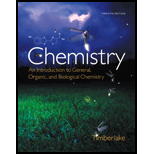
EBK CHEMISTRY
12th Edition
ISBN: 9780133911312
Author: Timberlake
Publisher: YUZU
expand_more
expand_more
format_list_bulleted
Question
Chapter 17.2, Problem 17.11QAP
Interpretation Introduction
Interpretation:
The way in which the nucleotides held together in a nucleic acid should be determined.
Concept introduction: Nucleic acid is formed by a series of nucleotides. A
Expert Solution & Answer
Want to see the full answer?
Check out a sample textbook solution
Students have asked these similar questions
Don't used Ai solution
Don't used Ai solution
Please correct answer and don't used hand raiting
Chapter 17 Solutions
EBK CHEMISTRY
Ch. 17.1 - Prob. 17.1QAPCh. 17.1 - Prob. 17.2QAPCh. 17.1 - Prob. 17.3QAPCh. 17.1 - Prob. 17.4QAPCh. 17.1 - Prob. 17.5QAPCh. 17.1 - Prob. 17.6QAPCh. 17.1 - Prob. 17.7QAPCh. 17.1 - Prob. 17.8QAPCh. 17.1 - Prob. 17.9QAPCh. 17.1 - Prob. 17.10QAP
Ch. 17.2 - Prob. 17.11QAPCh. 17.2 - Prob. 17.12QAPCh. 17.2 - Prob. 17.13QAPCh. 17.2 - Prob. 17.14QAPCh. 17.3 - Prob. 17.15QAPCh. 17.3 - Prob. 17.16QAPCh. 17.3 - Write the base sequence in a complementary DNA...Ch. 17.3 - Prob. 17.18QAPCh. 17.4 - Prob. 17.19QAPCh. 17.4 - Prob. 17.20QAPCh. 17.4 - Prob. 17.21QAPCh. 17.4 - Prob. 17.22QAPCh. 17.4 - Write the corresponding section of mRNA produced...Ch. 17.4 - Write the corresponding section of mRNA produced...Ch. 17.4 - What is a codon?Ch. 17.4 - Prob. 17.26QAPCh. 17.4 - Prob. 17.27QAPCh. 17.4 - Prob. 17.28QAPCh. 17.4 - Prob. 17.29QAPCh. 17.4 - Prob. 17.30QAPCh. 17.5 - Prob. 17.31QAPCh. 17.5 - Why are there at least 20 different tRNAs?Ch. 17.5 - Prob. 17.33QAPCh. 17.5 - Prob. 17.34QAPCh. 17.5 - Prob. 17.35QAPCh. 17.5 - Prob. 17.36QAPCh. 17.5 - Prob. 17.37QAPCh. 17.5 - Prob. 17.38QAPCh. 17.6 - Prob. 17.39QAPCh. 17.6 - Prob. 17.40QAPCh. 17.6 - Prob. 17.41QAPCh. 17.6 - Prob. 17.42QAPCh. 17.6 - How is protein synthesis affected if the normal...Ch. 17.6 - Prob. 17.44QAPCh. 17.6 - Prob. 17.45QAPCh. 17.6 - Prob. 17.46QAPCh. 17.6 - Prob. 17.47QAPCh. 17.6 - Prob. 17.48QAPCh. 17.7 - Prob. 17.49QAPCh. 17.7 - Prob. 17.50QAPCh. 17.7 - Prob. 17.51QAPCh. 17.7 - Prob. 17.52QAPCh. 17.7 - Prob. 17.53QAPCh. 17.7 - Prob. 17.54QAPCh. 17.7 - Prob. 17.55UTCCh. 17.7 - Suppose a mutation occurs in the DNA section in...Ch. 17.7 - Prob. 17.57AQAPCh. 17.7 - Prob. 17.58AQAPCh. 17.7 - Prob. 17.59AQAPCh. 17.7 - Prob. 17.60AQAPCh. 17.7 - Prob. 17.61AQAPCh. 17.7 - Prob. 17.62AQAPCh. 17.7 - Prob. 17.63AQAPCh. 17.7 - Prob. 17.64AQAPCh. 17.7 - Prob. 17.65AQAPCh. 17.7 - Prob. 17.66AQAPCh. 17.7 - Prob. 17.67AQAPCh. 17.7 - Prob. 17.68AQAPCh. 17.7 - Prob. 17.69AQAPCh. 17.7 - Prob. 17.70AQAPCh. 17.7 - Prob. 17.71AQAPCh. 17.7 - Prob. 17.72AQAPCh. 17.7 - Prob. 17.73AQAPCh. 17.7 - Prob. 17.74AQAPCh. 17.7 - Prob. 17.75AQAPCh. 17.7 - Prob. 17.76AQAPCh. 17 - Prob. 17.77CQCh. 17 - A polypeptide contains 36 amino acids. How many...Ch. 17 - Prob. 17.79CQCh. 17 - Prob. 17.80CQCh. 17 - Prob. 17.81CQCh. 17 - Prob. 17.82CQ
Knowledge Booster
Similar questions
- (12) Which one of the following statements about fluo- rometry is FALSE? a) Fluorescence is better detected at 90 from the exci- tation direction. b) Fluorescence is typically shifted to longer wave- length from the excitation wavelength. c) For most fluorescent compounds, radiation is pro- duced by a transitionarrow_forwardDon't used Ai solutionarrow_forwardDon't used Ai solutionarrow_forward
- Don't used Ai solutionarrow_forwardIndicate the correct option.a) Graphite conducts electricity, being an isotropic materialb) Graphite is not a conductor of electricityc) Both are falsearrow_forward(f) SO: Best Lewis Structure 3 e group geometry:_ shape/molecular geometry:, (g) CF2CF2 Best Lewis Structure polarity: e group arrangement:_ shape/molecular geometry: (h) (NH4)2SO4 Best Lewis Structure polarity: e group arrangement: shape/molecular geometry: polarity: Sketch (with angles): Sketch (with angles): Sketch (with angles):arrow_forward
- 1. Problem Set 3b Chem 141 For each of the following compounds draw the BEST Lewis Structure then sketch the molecule (showing bond angles). Identify (i) electron group geometry (ii) shape around EACH central atom (iii) whether the molecule is polar or non-polar (iv) (a) SeF4 Best Lewis Structure e group arrangement:_ shape/molecular geometry: polarity: (b) AsOBr3 Best Lewis Structure e group arrangement:_ shape/molecular geometry: polarity: Sketch (with angles): Sketch (with angles):arrow_forward(c) SOCI Best Lewis Structure 2 e group arrangement: shape/molecular geometry:_ (d) PCls Best Lewis Structure polarity: e group geometry:_ shape/molecular geometry:_ (e) Ba(BrO2): Best Lewis Structure polarity: e group arrangement: shape/molecular geometry: polarity: Sketch (with angles): Sketch (with angles): Sketch (with angles):arrow_forwardDon't used Ai solutionarrow_forward
arrow_back_ios
SEE MORE QUESTIONS
arrow_forward_ios
Recommended textbooks for you
 ChemistryChemistryISBN:9781305957404Author:Steven S. Zumdahl, Susan A. Zumdahl, Donald J. DeCostePublisher:Cengage Learning
ChemistryChemistryISBN:9781305957404Author:Steven S. Zumdahl, Susan A. Zumdahl, Donald J. DeCostePublisher:Cengage Learning ChemistryChemistryISBN:9781259911156Author:Raymond Chang Dr., Jason Overby ProfessorPublisher:McGraw-Hill Education
ChemistryChemistryISBN:9781259911156Author:Raymond Chang Dr., Jason Overby ProfessorPublisher:McGraw-Hill Education Principles of Instrumental AnalysisChemistryISBN:9781305577213Author:Douglas A. Skoog, F. James Holler, Stanley R. CrouchPublisher:Cengage Learning
Principles of Instrumental AnalysisChemistryISBN:9781305577213Author:Douglas A. Skoog, F. James Holler, Stanley R. CrouchPublisher:Cengage Learning Organic ChemistryChemistryISBN:9780078021558Author:Janice Gorzynski Smith Dr.Publisher:McGraw-Hill Education
Organic ChemistryChemistryISBN:9780078021558Author:Janice Gorzynski Smith Dr.Publisher:McGraw-Hill Education Chemistry: Principles and ReactionsChemistryISBN:9781305079373Author:William L. Masterton, Cecile N. HurleyPublisher:Cengage Learning
Chemistry: Principles and ReactionsChemistryISBN:9781305079373Author:William L. Masterton, Cecile N. HurleyPublisher:Cengage Learning Elementary Principles of Chemical Processes, Bind...ChemistryISBN:9781118431221Author:Richard M. Felder, Ronald W. Rousseau, Lisa G. BullardPublisher:WILEY
Elementary Principles of Chemical Processes, Bind...ChemistryISBN:9781118431221Author:Richard M. Felder, Ronald W. Rousseau, Lisa G. BullardPublisher:WILEY

Chemistry
Chemistry
ISBN:9781305957404
Author:Steven S. Zumdahl, Susan A. Zumdahl, Donald J. DeCoste
Publisher:Cengage Learning

Chemistry
Chemistry
ISBN:9781259911156
Author:Raymond Chang Dr., Jason Overby Professor
Publisher:McGraw-Hill Education

Principles of Instrumental Analysis
Chemistry
ISBN:9781305577213
Author:Douglas A. Skoog, F. James Holler, Stanley R. Crouch
Publisher:Cengage Learning

Organic Chemistry
Chemistry
ISBN:9780078021558
Author:Janice Gorzynski Smith Dr.
Publisher:McGraw-Hill Education

Chemistry: Principles and Reactions
Chemistry
ISBN:9781305079373
Author:William L. Masterton, Cecile N. Hurley
Publisher:Cengage Learning

Elementary Principles of Chemical Processes, Bind...
Chemistry
ISBN:9781118431221
Author:Richard M. Felder, Ronald W. Rousseau, Lisa G. Bullard
Publisher:WILEY